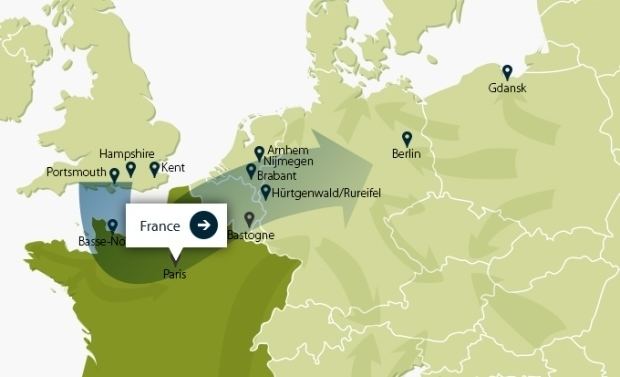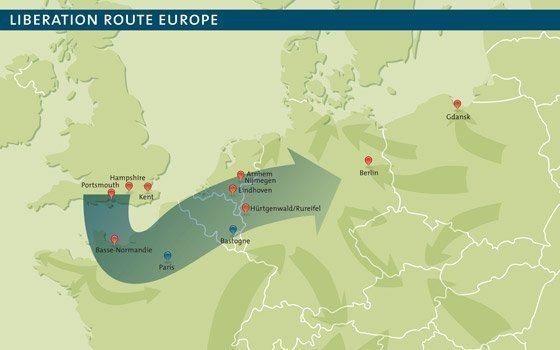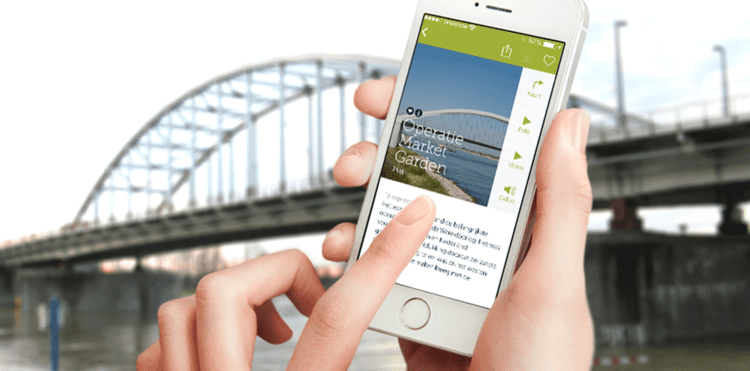 | ||
Liberation route europe trailer bij oorlog vrede introdans
Liberation Route Europe is an international remembrance trail that connects the main regions along the advance of the Western Allied Forces during the liberation of Europe and final stage of the Second World War. The route started in 2008 as a Dutch regional initiative in the Arnhem-Nijmegen area and then developed into a transnational route that was officially inaugurated in Arromanches on June 6, 2014 during the Normandy D-day commemorations. The route goes from Southern England through France, Belgium, Luxembourg, the Netherlands to Berlin, Germany and then extends to Poland. The southern route starts in Italy. As a form of remembrance tourism LRE aims to unfold these Allied offensives of 1944 and 1945 in one narrative combining the different perspectives and points of view. By combining locations with personal stories of people who fought and suffered, it gives visitors the opportunity to follow the Allied march and visit significant sites from war cemeteries to museums and monuments but also events and commemorations.
Contents
- Liberation route europe trailer bij oorlog vrede introdans
- Introduction to the liberation route europe
- Great Britain
- Normandy
- Paris
- Ardennes
- Brussels
- Luxembourg
- The Netherlands
- Gelderland
- North Brabant
- Overijssel
- Zeeland
- Limburg
- North Rhine Westphalia
- Berlin
- Gdask
- Italy
- The Liberation Route Europe Foundation
- References

Introduction to the liberation route europe
Great Britain
After the fall of France in 1940 and their own defeat on the continent, the British troops regrouped and took the air to defend their island, known as the Battle of Britain. The route starts in London and here goes through Kent (Operation Fortitude South, Operation Pluto and Operation Dynamo) and Hampshire (where Operation Overlord was prepared).
Important remembrance sites
Normandy

During Operation Overlord, the largest amphibious assault in history, Allied forces landed on five beaches along a 50-mile stretch of Normandy coast on D-Day. This operation marked the start of the liberation of Western Europe. The route here comprises the 5 landing beaches: Sword Beach (from Ouistreham to Saint-Aubin-sur-Mer), Gold Beach (between Port-en-Bessin and La Rivière), Utah Beach (Sainte-Marie-du-Mont), Omaha Beach (from Sainte-Honorine-des-Pertes to Vierville-sur-Mer), Juno Beach (from Courseulles to Saint-Aubin-sur-Mer) along with Pointe du Hoc (Criqueville-en-Bessin), Ranville (British Airlandings) or Longues-sur-Mer (German Battery).
The following Battle of Normandy resulted not only in the deaths of tens of thousands of soldiers, but also many French civilians. Almost all of the larger cities in the region were badly damaged.
Important remembrance sites

Paris
An uprising of the population against the Germans on August 19 forced the Allies to send troops to liberate Paris, while it was not a priority. The 2nd French Armoured Division entered Paris on the evening of August 24. The capitulation was signed on the Île de la Cité, and the German troops surrendered at the Montparnasse train station. Two days later a triumphal parade led by General Charles de Gaule was held on the Champs-Elysées.
Important remembrance sites
Ardennes
The Battle of the Bulge was the last major German offensive campaign launched through the densely forested Ardennes region. It eventually was gradually pushed back by the Allied until the Germans retreated behind the Siegfried Line.
Important remembrance sites
Brussels
Brussels was liberated on September 3d by the Guards Armoured Division of General Allan Adair including the Belgian 'Piron brigade'.
Important remembrance sites
Luxembourg
Luxembourg was the theatre of the Battle of the Bulge offensive and had to wait until 12 February 1945 before being completely liberated.
Important remembrance sites
The Netherlands
The Dutch section of Liberation Route Europe is concentrated in the provinces of Gelderland, North-Brabant, Overijssel, Zeeland and Limburg. In these provinces a large network of 176 'audiospots' has been developed to combine historical sites and personal stories.
Gelderland
The main historical places on the route here are Arnhem (Battle of Arnhem) Nijmegen (Operation Market Garden), Groesbeek (Operation Veritable), Wageningen (German capitulation), Oosterbeek (Operation Market Garden), Otterlo (Liberation of the East) and Lent (Men’s Island).
Important remembrance sites
North-Brabant
Important remembrance sites
Overijssel
Important remembrance sites
Zeeland
Important remembrance sites
Limburg
Important remembrance sites
North Rhine-Westphalia
During the autumn and winter of 1944-45, the longest battle of the Second World War on German soil took place in the Hürtgen Forest. With this battle, which ended in an Allied victory, the war returned to Germany and open the road to Berlin.
Seven 'audiospots' have been installed in the region.
Important remembrance sites
Berlin
Berlin is the endpoint of the route. The Battle of Berlin was one of the last battles of the Second World War in Europe. Many soldiers died in widespread house-to-house fighting where Soviet soldiers faced desperate German resistance. On May 2, 1945, the Berlin garrison surrendered to the Soviet army. The unconditional surrender of Germany was signed on the 8th.
Important remembrance sites
Gdańsk
On the 1st of September 1939 the battleship Schleswig-Holstein opened fire on the Westerplatte in Gdańsk. This is regarded as the first shots of the Second World War. After the war Gdansk would become an important symbol of Polish resistance.
Important remembrance sites
Italy
The Liberation Route Europe in Italy will connect important remembrance sites connected to the landing in Sicily, the Gustav Line defense, the Battle of Montecassino, the landing in Anzio, the Gothic Line defense.
The Liberation Route Europe Foundation
The Liberation Route Europe is developed and managed by the Liberation Route Europe Foundation. Its purpose is also to bring together all of the institutions related to World War II remembrance (museums, universities, regional and national governments, tourism authorities, veterans associations, war graves commissions etc.) and to coordinate their efforts at an international level.
Martin Schulz, current President of the European Parliament, serves as the patron of the Liberation Route Europe Foundation.
